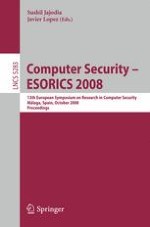These proceedings contain the papers selected for presentation at the 13th European Symposium on Research in Computer Security––ESORICS 2008––held October 6–8, 2008 in Torremolinos (Malaga), Spain, and hosted by the University of Malaga, C- puter Science Department. ESORICS has become the European research event in computer security. The symposium started in 1990 and has been organized on alternate years in different European countries. From 2002 it has taken place yearly. It attracts an international audience from both the academic and industrial communities. In response to the call for papers, 168 papers were submitted to the symposium. These papers were evaluated on the basis of their significance, novelty, and technical quality. Each paper was reviewed by at least three members of the Program Comm- tee. The Program Committee meeting was held electronically, holding intensive d- cussion over a period of two weeks. Finally, 37 papers were selected for presentation at the symposium, giving an acceptance rate of 22%.
